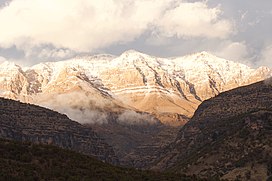| Zard-Kuh | |
|---|---|
 | |
| Highest point | |
| Elevation | 4,221 m (13,848 ft)[1] |
| Prominence | 2,095 m (6,873 ft)[1] |
| Listing | Ultra |
| Coordinates | 32°21′52″N 50°4′39″E / 32.36444°N 50.07750°E |
| Naming | |
| Native name | زردکوه (Persian) |
| English translation | Yellow Mountain |
| Geography | |
| Parent range | Zagros Mountains |

Zard-Kuh (meaning "Yellow Mountain", also spelled Zardkuh, Zarduh Kuh[2] or Zard Kuh-e Bakhtiari; Persian: زردکوه بختیاری) is a sub-range in the central Zagros Range, Iran.
With an elevation of 4,221 metres, its highest peak "Kolonchin" is located in the Kuhrang County, in the Chaharmahal and Bakhtiari Province of Iran.[3] The Karun and also Zayanderud rivers originate in the Zagros mountains near the Zard-Kuh. There are small glaciers on the mountain owing to the relatively high precipitation, which are the only glaciers in the subtropics outside the Himalayas, Andes and Trans-Mexican Volcanic Belt.[4]
Geologically, the Zard-Kuh is situated in the Sanandaj-Sirjan geologic and structural zone of Iran and is mainly made of Cretaceous limestone.[5]
The documentary Grass captures on film the Bakhtiari tribe's crossing of Zard-Kuh.
See also
[edit]References
[edit]- ^ a b "Iran: 54 Mountain Summits with Prominence of 1,500 meters or greater" Peaklist.org. Sources differ significantly on the elevation of this peak. Peakbagger for example gives an elevation of 4,548 m and a prominence of 2,443 m. Retrieved 2012-04-29.
- ^ Rawlinson, George. 2002. The Seven Great Monarchies of the Ancient Eastern World (Vol. 2: Babylonia, Media and Persia)
- ^ Microsoft Encarta World Atlas, 2001, Microsoft Corporation
- ^ Glaciers of Iran
- ^ Geological Map of Iran, National Geoscience Database of Iran, www.ngdir.ir
External links
[edit]

Well, that’s interesting to know that Psilotum nudum are known as whisk ferns. Psilotum nudum is the commoner species of the two. While the P. flaccidum is a rare species and is found in the tropical islands. Both the species are usually epiphytic in habit and grow upon tree ferns. These species may also be terrestrial and grow in humus or in the crevices of the rocks.
View the detailed Guide of Psilotum nudum: Detailed Study Of Psilotum Nudum (Whisk Fern), Classification, Anatomy, Reproduction